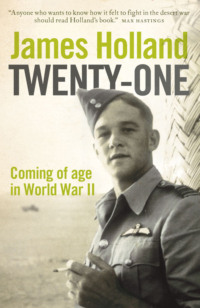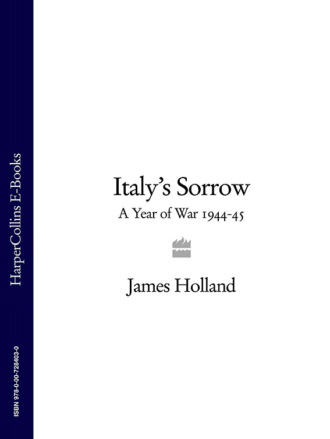
Полная версия
Italy’s Sorrow: A Year of War 1944–45

ITALY’S SORROW
A Year of War, 1944–1945
JAMES HOLLAND

For Daisy
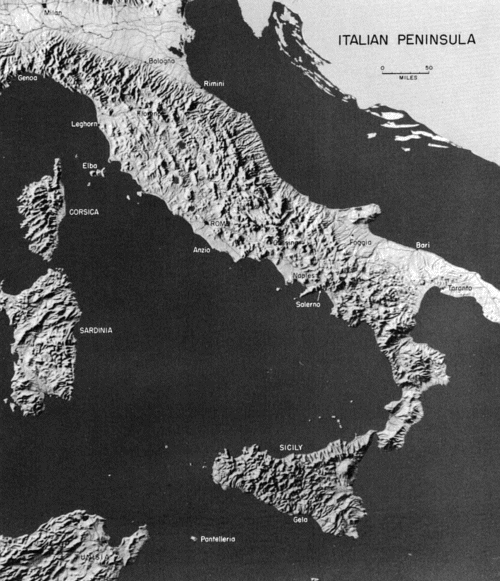
By the spring of 1944, the vast reach of Hitler’s Third Reich, chieved so spectacularly in the early part of the war, was diminishing. In the East, the Soviet Red Army was clawing back land lost and was about to regain the Crimea, while in the West, the Western Allies were poised to invade France. Already the Axis powers had lost North Africa and, the previous summer, Sicily. Mussolini, the Fascist dictator of Italy, had been deposed, and on 8 September 1943, the Italians surrendered to the Allies. With British troops already on the southern toe of the peninsula, the main Allied invasion force landed at Salerno, south of Naples, the morning after the Italian armistice. Thus began a long and bloody campaign that would cause untold suffering. Seven months of fighting, mostly in the intractable terrain around the town of Cassino, would wreak appalling destruction.
By May 1944, with the Italian winter behind them, the Allies were ready to renew their drive towards Rome. As the battle rolled north, the rest of Italy would become consumed by the campaign raging up its narrow leg. That year, from May 1944 to the war’s end almost exactly twelve months later, would be one of the most terrible in Italy’s history.
CONTENTS
List of Maps
Note on the Text
Principal Personalities
Prologue
Part I: The Road To Rome
1 The Eve of Battle: May 1944
2 Battle Begins: 11–12 May 1944
3 Churchill’s Opportunism
4 The Slow Retreat
5 Frustrations
6 Between the Devil and the Deep Blue Sea
7 Masters of the Skies
8 The Battle Rages: 13–16 May 1944
9 New Order
10 Breaking the Gustav Line: 17–18 May 1944
11 Achtung Banditen!
12 The Fog of War: 18–23 May 1944
13 Break-out: 23–26 May 1944
14 General Clark and the Big Switch: 26–30 May 1944
15 The Fall of Rome: 1–5 June 1944
Part II: The Brutal Summer
16 The North
17 The Problems of Generalship: June 1944
18 The Typhoon Rolls North
19 Breaking the Albert Line: 20–30 June 1944
20 The Politics of War
21 Differences of Opinion
22 Summer Heat: July 1944
23 Crossing the Arno: July–August 1944
24 A Change of Plan: August 1944
25 Despair: August 1944
26 The Gothic Line: 25 August–1 September 1944
27 The Tragedy of Gemmano: 1–12 September 1944
28 Mountain Passes and Bloody Ridges: 12–21 September 1944
Part III: The Winter of Discontent
29 Death in the Mountains: 22–29 September 1944
30 The Reason Why
31 Rain, Mud and Misery, Part I: 1–14 October 1944
32 Rain, Mud and Misery, Part II: 15–31 October 1944
33 The Infantryman’s Lot: November 1944
34 The Partisan Crisis: November–December 1944
35 White Christmas: December 1944
Part IV: Endgame
36 Stalemate: January–February 1945
37 Getting Ready: February–April 1945
38 The Last Offensive: 9–20 April 1945
39 The End of the War in Italy: 21 April–2 May 1945
Postscript
References
Bibliography
Acknowledgements
Abbreviations and Glossary
Guide to ranks
Index
Copyright
About The Publisher
MAPS
Italy showing German defensive lines
Cassino front, 11 May 1944, and Alexander’s battle plan for DIADEM and the destruction of AOK 10 south of Rome
The Monte Sole massif
Operational zone of the 8th Garibaldi Brigade of Partisans, also showing the river network Eighth Army had to cross, September 1944 to April 1945
The Val d’Orcia
Northern Italy, Lake Como and Lake Garda
Main Italian rail network and ports
Allied Control Commission Organisation of Italy, 1 September 1944
The Winter Line, January 1945
DIADEM: The battle for Rome and German lines of retreat for AOK 10
The Allied pursuit from Rome to the Albert Line, 5–20 June 1944
From the Albert Line to the River Arno, July and early August 1944
Alexander’s battle plan for the Gothic Line, August 1944
Eighth Army’s attack on the Gothic Line, August to September 1944
Fifth Army’s assault on the Gothic Line, 10–18 September 1944
The German attack on Monte Sole
Fifth Army’s attempt to break through the Apennines, 1–15 October 1944
The final offensive, April to May 1945
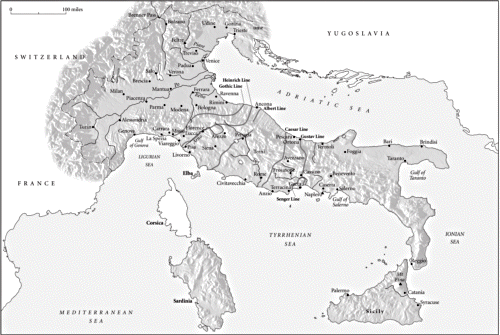
Italy showing German defensive lines
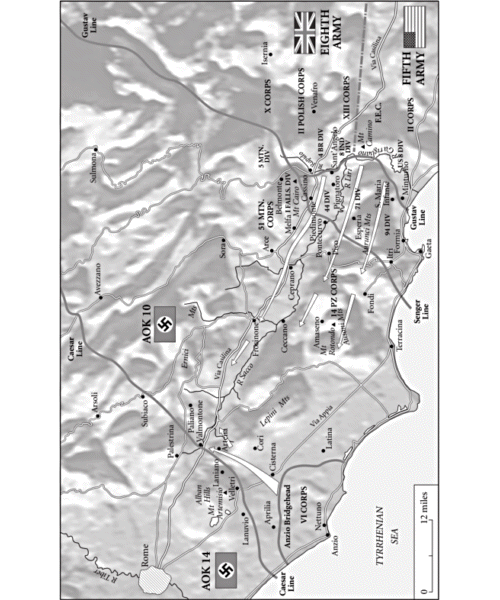
Cassino front, 11 May 1944, and Alexander’s battle plan for DIADEM and the destruction of AOK 10 south of Rome
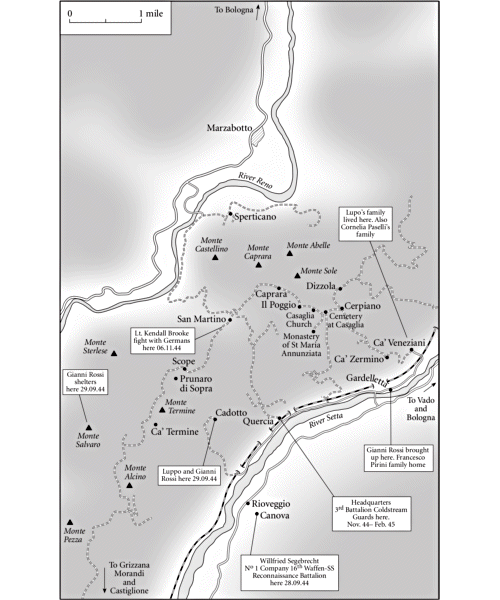
The Monte Sole massif

Operational zone of the 8th Garibaldi Brigade of Partisans, also showing the river network Eighth Army had to cross (Sept. 1944–April 1945)
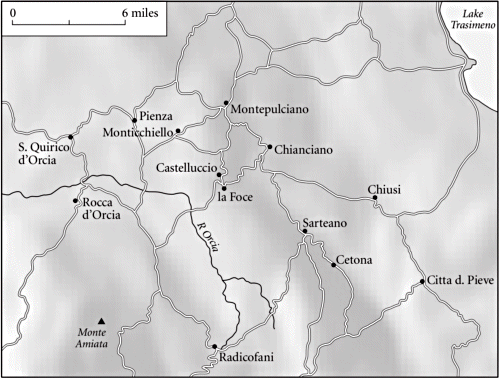
The Val d’Orcia
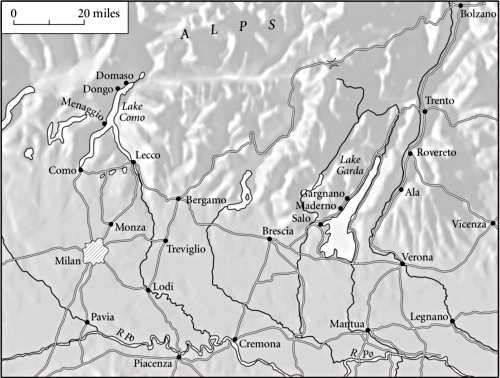
Northern Italy, Lake Como and Lake Garda
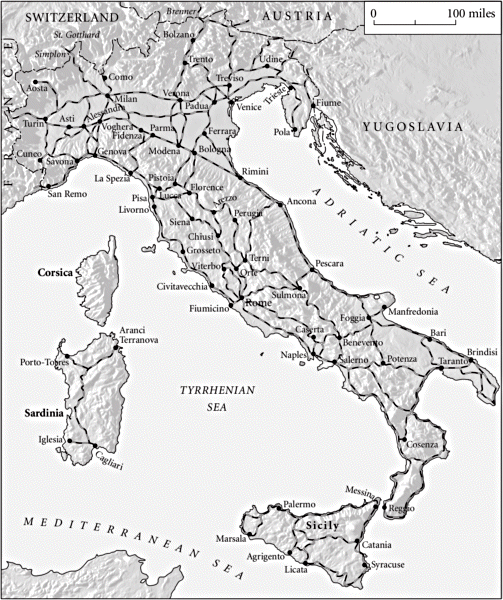
Main Italian rail network and ports
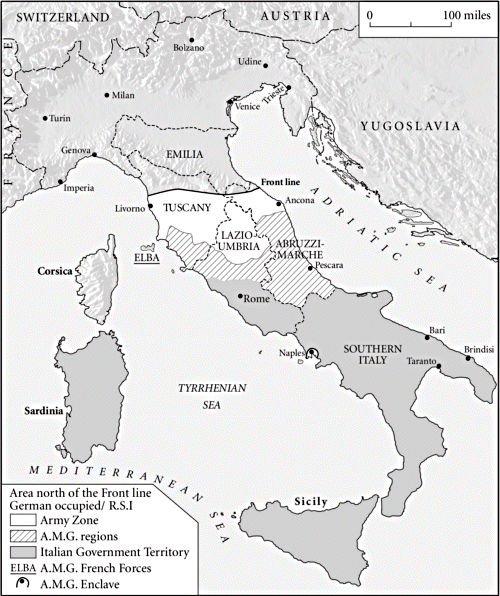
Allied Control Commission Organisation of Italy, 1 Sept. 1944
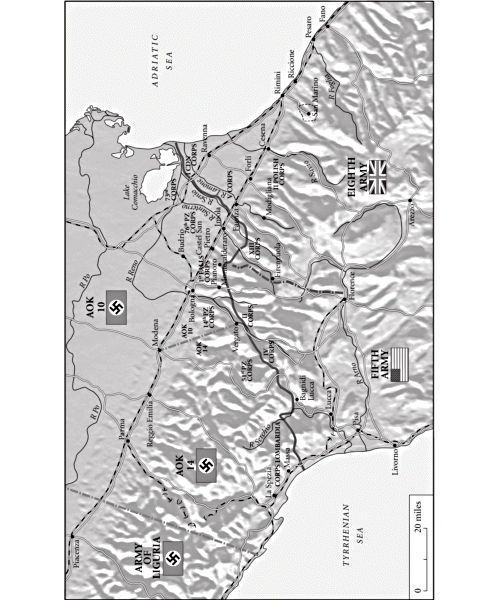
The Winter Line, January 1945
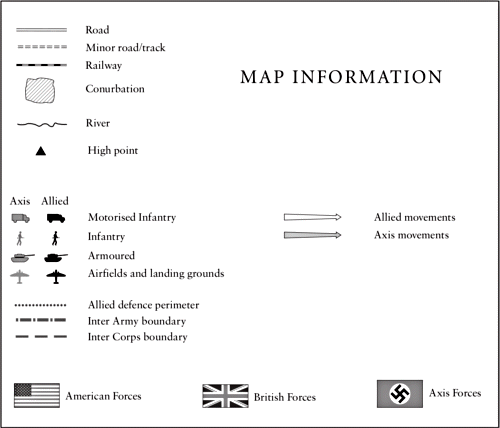
NOTE ON THE TEXT
One of the difficulties faced when writing about different armies of different nationalities is that many units have similar names. Furthermore, many American servicemen also have Germanic-sounding names. So in an effort to avoid any confusion, I have used the German spellings for the names of military units and ranks. For example, the German name for an army was Armeeoberkommando, or AOK as it was known; paratroopers were called Fallschirmjäger; armoured divisions were called panzer divisions. I have also included as an appendix to the book a comparison of military ranks.
On the other hand, I have translated Italian ranks, but have kept certain Italian words in their true form where there is no appropriate translation, such as contadini, who were Italian peasant farmers, and rastrellamento, the word to describe a military operation to clear an area of partisans.
Traditionally, army numbers are spelled out, and corps numbers given in Roman numerals. However, I have used numerical figures to describe German corps, purely because LXXVI Panzer Corps seems unnecessarily long-winded. I hope readers will accept these inconsistencies and anomalies in the spirit in which they were intended.
PRINCIPAL PERSONALITIES (ranks as at end of war)
Cosimo Arrichiello Italian former soldier with Fourth Someggiata Field Battery; agricultural labourer hiding in the Stura Valley south of Turin
John Barton British officer and agent with SOE, Italy
Sam Bradshaw British reconnaissance trooper with 6 Royal Tank Regiment, 7th Armoured Brigade
Kendall Brooke South African subaltern with A Coy, Royal Natal Carbineers, 6th SA Armoured Division
Friedrich Büchner German trainee artillery officer with 98th Infantry Division
Albert Burke American master sergeant with Divisional HQ, 92nd ‘Buffalo’ Infantry Division
Ion Calvocoressi British senior aide-de-camp to General Sir Oliver Leese, Tactical HQ, Eighth Army
Carla Capponi Italian civilian and member of Rome-based resistance movement GAP Central
Eugenio Corti Italian lieutenant with 184th Artillery Regiment, Nembo Division, CIL, later Folgore Combat Group
Carla Costa Italian civilian spy with German Intelligence Service (Abwehr)
William Cremonini Italian sergeant with Bir el Gobi Company, Alessandro Pavolini’s personal bodyguard
Antonio Cucciati Italian teenager paratrooper with Nuotati e Paracadutisti Battalion, Flottiglia Decima MAS
Elena Curti Italian civilian and illegitimate daughter of Benito Mussolini, working for government of the RSI
Charles Dills American fighter pilot with 522nd Squadron, 27th Fighter Bomber Group
Group Captain Hugh ‘Cocky’ Dundas British airman serving as wing commander, HQ Desert Air Force, 244 Wing; commanding officer, 244 Wing, RAF
Clara Duse Italian civilian living in Trieste
Tom Finney British trooper with 9th Queen’s Royal Lancers, 78th Division
Dick Frost South African lance corporal with D Squadron, Royal Natal Carbineers, 12th Motor Infantry Brigade, 6th SA Armoured Division
Martha Gellhorn American freelance journalist and war correspondent with Collier’s Magazine. Estranged wife of the writer Ernest Hemingway
Tini Glover Maori sergeant with 28th Maori Battalion, 2nd New Zealand Division
Hans Golda German commanding officer serving with 8th Battery, Werfer Regiment 71
Reg Harris British sergeant with 3rd Battalion, Coldstream Guards
Stephen Hastings British liaison officer with No 1 Special Force, SOE in Piacenza
Willi Holtfreter German fighter pilot with fighter group III/JG 53
Hamilton Howze American commander, 13th Armored Battalion; later commander Combat Command B, 1st Armored Division
Jupp Klein German commander with Pioneer Company, 1st Fallschirmjäger Division
Hans-Jürgen Kumberg German paratrooper with 4th Parachute Regiment, 1st Paratroop Division
Norman Lewis British intelligence officer with 412th Field Security Service
Franz Maassen German NCO with 2nd Battalion, 994th Infantry Regiment, 278th Infantry Division
Iader Miserocchi Italian partisan commander of 2nd Battalion, 8th Garibaldi Brigade; later served with 28th Garibaldi Brigade
Peter Moore British officer with 2/5th Battalion, Leicestershire Regiment
Ken Neill New Zealander flight commander with 225 Tactical Reconnaissance Squadron, RAF
Marchesa Iris Origo Irish/American/Italian civilian living in Val d’Orcia, southern Tuscany
Cornelia Paselli Italian civilian living near Monte Sole
Francesco Pirini Italian civilian living near Monte Sole
Pasua Pisa Italian civilian farmer living on Monte Rotondo, near Amaseno
Italo Quadrelli Italian civilian living at Onferno, near Rimini
Walter Reder German commanding officer, 16th Reconnaissance Battalion, 16th Waffen-SS
Gianni Rossi Italian partisan; served as second-in-command, Stella Rossa, Monte Sole
Wladek Rubnikowicz Polish troop leader with 2nd Squadron, 12th Lancers Reconnaissance Regiment, 3rd Carpathian Division, II Polish Corps
Emilio Sacerdote Italian Jew and partisan in Piemonte
Ray Saidel American private first class with G Coy, 1st Armored Regiment, 1st Armored Division
Rudi Schreiber German engineer with Pioneer Battalion, 16th Waffen-SS Panzer Grenadier Division
Stan Scislowski Canadian private with Perth Regiment, 11th Infantry Brigade, 5th Canadian Armoured Division
Willfried Segebrecht German commanding officer, 1 Company, 16th Reconnaissance Battalion, 16th Waffen-SS
Eric Sevareid American broadcast journalist and war correspondent for CBS
Hans Sitka Czech German NCO with East Regiment
Carlo Venturi Italian partisan with Stella Rossa and later 62nd Garibaldi Brigade
Roberto Vivarelli Italian volunteer with Bir el Gobi Company
Ernest Wall British wireless operator/air gunner with 1 Squadron, South African Air Force
Bucky Walters American sergeant with H Coy, 135th Infantry Regiment, 34th ‘Red Bull’ Infantry Division
Bob Wiggans American commanding officer with ‘D’ Coy, 1st Battalion, 338th Infantry, 85th ‘Custer’ Infantry Division
Ted Wyke-Smith British officer with 281st Field Park Company, 214th Field Company, 78th Division Royal Engineers
Georg Zellner German commanding officer with 3rd Battalion, ‘Hochund-Deutschmeister’ Reichs Grenadier Regiment (44th Infantry Division)
PROLOGUE
A few minutes before two o’clock on the afternoon of Thursday, 23 March 1944, Rome was a city bathed in spring sunshine and temperatures that were easily the warmest so far that year. But while the promise of summer may have lightened the mood of the majority of Romans, the heat brought no such cheer to twenty-two-year-old Carla Capponi, or ‘Elena’ as she was known amongst her fellow partisans. Clasping a pistol in her pocket, she was already feeling conspicuous for carrying a man’s raincoat on such a beautiful day.
A couple of hours before, she had been too nervous to have any of the beer and potatoes on offer for lunch. Instead, she and her boyfriend, Rosario ‘Paolo’ Bentivegna, and two other partisans of the Roman resistance group GAP Central – the Gruppi di Azione Patriottica Centrale – had left their meal and hurried over to the hideout near the Colosseum. There Paolo had collected the old dust cart that had been stolen the day before, in which there was now hidden a homemade bomb of 18 kilogrammes of TNT topped by a 50-second fuse. While the bomb was big enough to destroy an entire building, the Gappists had planned to bolster their attack with mortars and gunfire. It had been Carla’s job to pick up four mortars from the hide-out and deliver them to ‘Francesco’, a fellow partisan, waiting in the Via del Traforo. Carrying the mortars in nothing more than a shopping bag, she had managed safely to deliver them to Francesco, and then, as she had walked past, had glanced down the Via Rasella. It had been quite deserted; Paolo, with his heavy bomb-laden dustcart, had not yet reached his appointed position.
Passing the bottom of the Via Rasella, Carla had continued up the Via del Traforo and was now waiting by the offices of Il Messaggero newspaper. She spotted Pasquale Balsamo, another partisan, standing by a news-stand. Perhaps he could sense her nerves in the taut expression in her face, because as he looked across he gave her a reassuring wink.
At least they were both now in position. It was Pasquale’s job to give Carla the signal to let her know that the German troops were on their way. She would then turn right onto the Via del Tritone, a main thoroughfare that ran roughly parallel to the Via Rasella, and after 300 yards, turn right again onto another main street, the Via delle Quattro Fontane, until she reached the top end of Via Rasella. There she would wait for Paolo with the raincoat – the overcoat that was to cover up his dustman’s uniform as they attempted to make good their escape.
Standing by Il Messaggero, Carla paused to look at the newspaper pinned in a display case outside the entrance, keeping half an eye out for Pasquale’s reflection in the glass in front of her. Nearby, far too close for comfort, were two men – very obviously plainclothes policemen. The newspaper was full of news about the eruption of Mount Vesuvius five days earlier, but as her eyes flickered over the newsprint she was conscious that too much time was going by. Why hadn’t Pasquale given her the signal? And where were the SS troops? The whole operation had been built around the Germans’ unvarying Teutonic routine: every day, without fail, the same column of around 160 men of the 11th Company of the 3rd Battalion of the SS Police Regiment Bozen would march through the centre of the city on their way back to their barracks after a morning’s training at a shooting range near the Roman bridge, Ponte Milvio. As they marched, singing ‘Hupf, Mein Mädel!’ – ‘Skip, My Lassie’ – they would pass up the length of the comparatively narrow and enclosed Via Rasella.
A quarter past two came and went. Then 2.20 p.m., 2.30 p.m., 2.45 p.m. and still no sign of the troops. The plainclothes policemen approached her. As they did so Carla gripped the pistol in her pocket. ‘Excuse me, signorina,’ one of them said to her. ‘Are you waiting for someone?’ For a split second she froze, then said, yes, she was waiting for her fiancé, who, she explained, worked at the Palazzo Barberini. She then began talking to them about the eruption of Vesuvius and the potential disaster this might cause for Naples. This seemed to work. She felt calmer suddenly, so that when one of them asked her sharply why she was carrying a raincoat on such a hot day, she told them that it was her fiancé’s and that she had had a stain removed from it and was going to give it back to him.
She then saw Pasquale start towards her. What was the time? She asked the policemen: 2.47 p.m. one of them told her. In that case, she said, it was time for her to go. Hurrying away from them, she passed Pasquale who muttered something she could not make out, but knowing she could not look back and believing Pasquale’s message was the signal for her to move, she turned into the Via del Tritone and then down Quattro Fontane to take up her position for the attack.
At the top of Via Rasella, Carla saw Paolo sweeping the road half way down the street, the dustcart in the middle of the road. She had been expecting to see the SS column marching into the bottom of the street but there was still no sign. She could not think what had gone wrong. One of only twelve partisans from GAP Central, she was well aware that their chances of pulling off such an attack and then successfully escaping were not high. Life in Rome was becoming increasingly dangerous with not only the Gestapo closing in on them but also the Neo-Fascist secret police. There was also a particularly vicious gang of Fascist vigilantes, which had been set up soon after the German occupation the previous autumn as a counter-partisan ‘Special Police Unit’. Known as the Koch Gang after its leader, Pietro Koch, the band was already a byword for ruthlessness and brutality, known for the particular vindictiveness with which they tortured those who fell into their grasp.
The growing dangers had done little to deter the Gappists, but all of the partisans in GAP Central, Carla included, were very aware that their planned attack in the Via Rasella was the most daring strike attempted yet. The night before, lying next to Paolo in their hide-out, she had needed to remind herself why she was taking part in such an action. In the silence and dark, she had thought of how unjust the war was, and of the destruction and devastation it had caused to her country. She thought of her compatriots who had already been shot and tortured and of all those who had been deported and who had not been heard of since; and she thought of all those friends of hers who had already died in the fighting in Russia, in Greece, in Yugoslavia; she remembered her cousin, Amleto, killed fighting the Allies at El Alamein. But while such thoughts had helped stiffen her resolve, her fears remained. If they were caught, she knew they would be killed.
At the top of the Via Rasella, in the garden of the Palazzo Barberini, Carla spotted some children playing football. Imagining the horrors of the children being caught in the bomb blast she walked over and shouted at them, ‘You can’t play football in this garden. Go home and do your homework!’ Recognising something in her tone, they all immediately scurried off.
The minutes ticked by. Still nothing. What could have gone wrong? As she waited by the gates of the Palazzo Barberini the same two plainclothes policemen approached her again. It was now just after 3.30 p. m., more than an hour and a half after the bomb was supposed to have gone off. ‘You still here?’ they asked her. Her fiancé was at the Officer’s Club in the Palazzo, she told them, desperately hoping they would not see Paolo and his rubbish cart a hundred yards up ahead. She couldn’t go in there, she explained, as it was men only, and so had to wait. ‘We’ll wait with you,’ they told her.
Carla was almost at her wits’ end when she spotted an elderly friend of her mother’s on the other side of Quattro Fontane. Excusing herself from the two policemen, she hurried across the road and after a very brief conversation, whispered to her to get away as quickly as possible.
It was at that moment that she saw one of the other partisans walking down the street towards Paolo. As he passed, Carla finally spotted the head of the column of SS men turn into the bottom of the Via Rasella. Her heart in her mouth, she watched them gradually fill the entire street, tramping rhythmically – though not singing as usual – towards Paolo and the dustcart, until he was lost from view, engulfed by the marching column.
She was still straining to see him when he suddenly appeared by her side. The front of the column was now near the top of the Via Rasella. She gave him the raincoat, which he hastily put on over his overalls, just as Carla saw the two plainclothes policemen, who had not stopped watching her, begin to cross the street. She pulled out her pistol but a passing bus came between them.
And then the bomb detonated.
The explosion rocked the entire city centre. A violent blast of air followed, pushing Carla and Paolo forward and knocking the bus, directly in front of the Via Rasella, across the street. The policemen fled and Carla and Paolo sprinted in the opposite direction, gunfire and bullets from the troops at the head of the column pinging and ricocheting all around them and bits of stone and stucco from the buildings showering them as they ran. Behind them mortars exploded, but they both kept running, sprinting for their lives until the sounds of the inferno at last began to die down.


